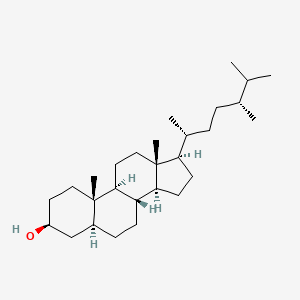| Authors | Title | Published | Journal | PubMed Link |
|---|---|---|---|---|
| Ostlund RE et al. | Gastrointestinal absorption and plasma kinetics of soy Delta(5)-phytosterols and phytostanols in humans. | 2002 | Am. J. Physiol. Endocrinol. Metab. | pmid:11882512 |
| Hallikainen M et al. | Short-term LDL cholesterol-lowering efficacy of plant stanol esters. | 2002 | BMC Cardiovasc Disord | pmid:12197945 |
| Plat J and Mensink RP | Effects of diets enriched with two different plant stanol ester mixtures on plasma ubiquinol-10 and fat-soluble antioxidant concentrations. | 2001 | Metab. Clin. Exp. | pmid:11319712 |
| Xu G et al. | Plant stanol fatty acid esters inhibit cholesterol absorption and hepatic hydroxymethyl glutaryl coenzyme A reductase activity to reduce plasma levels in rabbits. | 2001 | Metab. Clin. Exp. | pmid:11555847 |
| Asami T et al. | Selective interaction of triazole derivatives with DWF4, a cytochrome P450 monooxygenase of the brassinosteroid biosynthetic pathway, correlates with brassinosteroid deficiency in planta. | 2001 | J. Biol. Chem. | pmid:11319239 |
| Nomura T et al. | Accumulation of 6-deoxocathasterone and 6-deoxocastasterone in Arabidopsis, pea and tomato is suggestive of common rate-limiting steps in brassinosteroid biosynthesis. | 2001 | Phytochemistry | pmid:11382232 |
| Volger OL et al. | Dietary vegetable oil and wood derived plant stanol esters reduce atherosclerotic lesion size and severity in apoE*3-Leiden transgenic mice. | 2001 | Atherosclerosis | pmid:11472737 |
| Wasan KM et al. | Assessing plasma pharmacokinetics of cholesterol following oral coadministration with a novel vegetable stanol mixture to fasting rats. | 2001 | J Pharm Sci | pmid:11064375 |
| Volger OL et al. | Dietary plant stanol esters reduce VLDL cholesterol secretion and bile saturation in apolipoprotein E*3-Leiden transgenic mice. | 2001 | Arterioscler. Thromb. Vasc. Biol. | pmid:11397718 |
| Salen G et al. | Hyperabsorption and retention of campestanol in a sitosterolemic homozygote: comparison with her mother and three control subjects. | 2000 | J. Lipid Res. | pmid:11060358 |
Campestanol
Campestanol is a lipid of Sterol Lipids (ST) class. The involved functions are known as Oxidation. The related lipids are campestanol, Sterols, campesterol and 6-oxocampestanol.
Cross Reference
Introduction
To understand associated biological information of Campestanol, we collected biological information of abnormalities, associated pathways, cellular/molecular locations, biological functions, related genes/proteins, lipids and common seen animal/experimental models with organized paragraphs from literatures.
What diseases are associated with Campestanol?
There are no associated biomedical information in the current reference collection.
No disease MeSH terms mapped to the current reference collection.
PubChem Associated disorders and diseases
What pathways are associated with Campestanol
Lipid pathways are not clear in current pathway databases. We organized associated pathways with Campestanol through full-text articles, including metabolic pathways or pathways of biological mechanisms.
Related references are published most in these journals:
| Pathway name | Related literatures |
|---|
PubChem Biomolecular Interactions and Pathways
Link to PubChem Biomolecular Interactions and PathwaysWhat cellular locations are associated with Campestanol?
There are no associated biomedical information in the current reference collection.
What functions are associated with Campestanol?
Related references are published most in these journals:
| Function | Cross reference | Weighted score | Related literatures |
|---|
What lipids are associated with Campestanol?
Related references are published most in these journals:
| Lipid concept | Cross reference | Weighted score | Related literatures |
|---|
What genes are associated with Campestanol?
There are no associated biomedical information in the current reference collection.
What common seen animal models are associated with Campestanol?
There are no associated biomedical information in the current reference collection.
